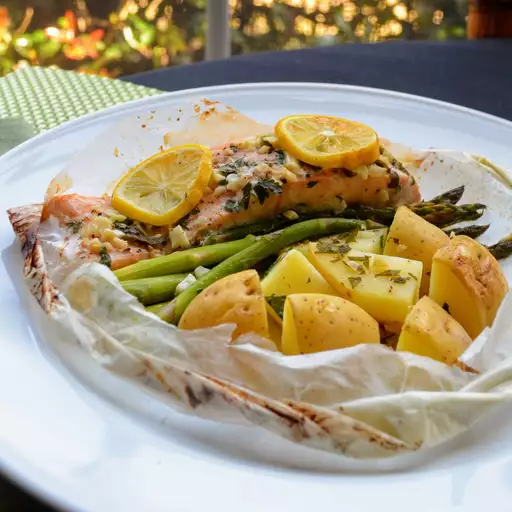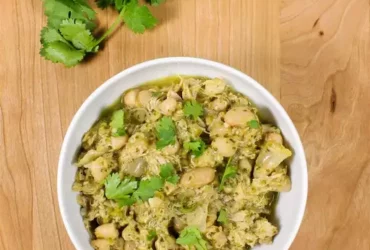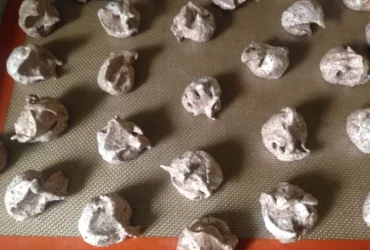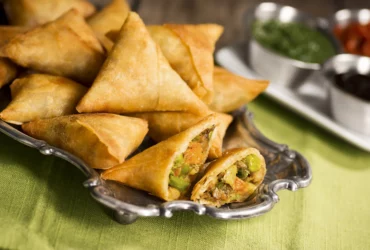Ingredients
Fresh salmon fillets
Fresh salmon fillets are the star of the show in this recipe. It’s essential to use high-quality, fresh fish for the best flavor and texture. When selecting salmon, look for fillets that have a vibrant pink color and a firm, smooth texture. The skin should be intact and glossy, without any signs of drying out or damage.
The ideal salmon fillet is around 6-8 ounces (170-225 grams) in weight and about 1-inch (2.5 cm) thick. This size ensures that the fish cooks evenly and stays moist throughout the cooking time. You can find fresh salmon fillets at most seafood markets, high-end grocery stores, or even some well-stocked supermarkets.
It’s worth noting that farmed salmon is often less expensive than wild-caught salmon, but it may have a slightly different taste and texture. If you prefer the richer flavor of wild-caught salmon, be prepared to pay a bit more for it. Regardless of whether you choose farmed or wild-caught salmon, make sure it’s fresh and stored properly to ensure the best flavor and food safety.
Before using the salmon fillets in this recipe, rinse them under cold water and pat them dry with paper towels to remove any excess moisture. This step is crucial to prevent steam from building up inside the parchment paper and causing the fish to cook unevenly or even become overcooked.
Finally, choose salmon that has been sustainably sourced and is free of contaminants like mercury, PCBs, and other pollutants. This not only ensures food safety but also supports environmentally responsible fishing practices and helps preserve our planet’s marine ecosystems for future generations.
Fresh salmon is a fatty fish with high nutritional value and rich in omega3 fatty acids, as per National Oceanic and Atmospheric Administration (NOAA).
- Fresh salmon is an excellent source of protein, low in saturated fat and high in omega-3 fatty acids.
- Omega-3 fatty acids play a crucial role in heart health by reducing inflammation and improving blood lipid profiles.
- The American Heart Association recommends consuming at least two servings (about 8 ounces) of fish rich in omega-3s each week, with salmon being an ideal option.
- Fish like salmon that are high in fat content tend to be more flavorful and moist when cooked properly.
When selecting fresh salmon for Chef John’s Salmon in Parchment Recipe, look for:
- A firm texture with no signs of softness or sogginess
- A pleasant ocean-like smell without any ammonia or fishy odors
- A vibrant color with a slightly reddish tint, depending on the type of salmon
- No visible signs of damage, cuts, or bruises
Some common types of fresh salmon that are well-suited for Chef John’s Salmon in Parchment Recipe include:
- Sockeye (Red) salmon: Known for its rich, intense flavor and firm texture.
- Coho (Silver) salmon: Offers a slightly sweeter flavor profile than sockeye with a similar texture.
- Atlantic salmon: A more affordable option with a milder flavor and firmer texture than some other types.
Remember to handle the fish gently, store it properly in the refrigerator, and cook it as directed by Chef John’s recipe for maximum freshness and safety.
Parchment paper
The success of Chef John’s Salmon in Parchment recipe heavily relies on the quality and selection of ingredients used. A fundamental aspect of this dish is the utilization of Parchment Paper, which serves as a heat-resistant barrier that allows for even cooking while preventing the salmon from sticking to the pan.
For the recipe, you will need:
- Salmon Fillets (6 ounces each)
- Lemons, juiced (2 tablespoons)
- Olive Oil (2 tablespoons)
- Garlic Cloves (minced, 2 cloves)
- Capers (chopped, 1 tablespoon)
- Dill Weed (chopped, 1 tablespoon)
- Black Pepper (to taste)
- Salt (to taste)
- Parchment Paper
The selection of salmon fillets is crucial, as they should be fresh and of high quality. Look for fillets that are about 1 inch thick to ensure even cooking. Additionally, make sure to pat the salmon dry with paper towels before proceeding with the recipe.
Heavyduty parchment paper helps to create a steamy environment for the fish to cook evenly.
- In this recipe, heavy-duty parchment paper plays a crucial role in helping the salmon cook evenly and retain its moisture. The paper acts as an enclosure that traps steam and heat, creating a microclimate around the fish.
- When you place the salmon on the parchment paper with some aromatics like lemon slices and herbs, it allows for even cooking throughout. The paper prevents the fish from drying out by retaining the juices and flavors that are released during cooking.
- The heavy-duty quality of the parchment paper is essential in this recipe. It can withstand high temperatures without burning or disintegrating, ensuring that the salmon cooks consistently and evenly.
- The parchment paper also makes it easy to cook the salmon with minimal cleanup required after cooking. Simply place the pouch on a baking sheet and bake until the fish is cooked through, then serve hot.
Herbs and spices
The success of Chef John’s Salmon in Parchment Recipe largely relies on the thoughtful selection and combination of its key ingredients, herbs, and spices.
For a dish that promises to bring out the natural flavors of salmon while also providing a subtle aromatic depth, it is crucial to choose high-quality ingredients. This begins with the salmon fillet itself, which should be fresh and preferably wild-caught for optimal flavor and nutritional value.
The accompanying vegetables – onions, carrots, and lemons – should be selected based on their sweetness, crunchiness, and ability to hold their texture during cooking. The onion’s pungency will provide a savory base note, while the carrot adds natural sweetness, balancing the flavors in each bite.
The aromatic herbs – thyme, rosemary, and parsley – play a crucial role in creating a fragrant and visually appealing dish. Thyme brings a slightly minty flavor with hints of earthiness, complementing the fish’s rich taste, while rosemary contributes its piney aroma to enhance the overall freshness.
Parsley, with its mild bitterness and hint of sweetness, adds depth without overpowering other flavors. Fresh parsley is essential as dried versions can lose their vibrant green color and distinct flavor over time.
Spices and seasonings like black pepper and salt are fundamental to bringing out the best in the salmon’s natural flavor while maintaining a delicate balance between sweet, salty, and savory notes.
The lemon slices, providing an acidic kick, will help cut through the richness of the dish without overpowering the other flavors. The citrus will also enhance the herbal aromas and contribute to a refreshing finish.
In sum, a thoughtful choice of ingredients – including fresh salmon, herbs like thyme, rosemary, and parsley, and spices such as black pepper and salt – is crucial for achieving the delicate balance and rich flavors in Chef John’s Salmon in Parchment Recipe.
Lemon juice, olive oil, salt, and pepper are commonly used ingredients in cooking salmon.
- Lemon juice is a common ingredient used to add flavor and moisture to salmon when cooked. It helps to balance the richness of the fish and adds a burst of citrus flavor.
- Olive oil, on the other hand, is often used as a finishing oil for salmon. It’s typically added towards the end of cooking to prevent it from becoming rancid and to enhance the flavors already present in the dish.
- Salt is another essential ingredient when cooking salmon, but be careful not to overdo it. Too much salt can make the fish taste bitter and overpowering. A pinch or two will do the trick.
- Pepper, like salt, should be used sparingly as well. Fresh black pepper adds depth and warmth to the dish without overpowering the delicate flavor of the salmon.
- These four ingredients, when combined in Chef John’s Salmon in Parchment Recipe, create a harmonious balance of flavors that enhance the natural taste of the salmon. The lemon juice provides acidity, while the olive oil adds richness and depth.
- The salt and pepper add a touch of seasoning without overpowering the dish, allowing the freshness of the fish to shine through. This combination makes for an exceptional culinary experience when cooking salmon in parchment paper.
Cooking Instructions
Slice the lemon
In Chef John’s Salmon in Parchment Recipe, slicing the lemon is an essential step that adds a burst of citrus flavor to the dish. To slice the lemon, start by washing it under cold running water to remove any dirt or wax residue.
Next, dry the lemon with a clean towel to prevent slipping while cutting. Position the lemon on a stable surface and locate the equator, which is the middle section of the lemon where it begins to curve downward.
Gently press down on the lemon at an angle, using a gentle sawing motion with your knife to cut through the lemon in a circular motion, starting from the top and working your way around to the bottom. Be careful not to apply too much pressure, as this can cause the lemon to roll off the cutting board.
As you make your way around the lemon, use gentle, smooth strokes to remove any seeds that may have been dislodged during the cutting process. Continue cutting until you reach the equator of the lemon again, creating a second cut that meets the first one.
Hold both sides of the lemon together and squeeze them gently in opposite directions, allowing the two halves to separate. Use your fingers or a spoon to scoop out any remaining seeds or white pith from the center of each half.
Finally, place the sliced lemons on top of the salmon fillets in the parchment paper package, reserving the juice for serving as a garnish. Make sure to cut the lemon slices thinly and evenly so that they don’t overpower the delicate flavor of the salmon.
Thin slices of lemon will add flavor to the fish without overpowering it.
Chef John’s Salmon in Parchment recipe is a popular dish that showcases the delicate flavors of salmon paired with the brightness of lemon and herbs, all wrapped up in a flavorful package.
To enhance the flavor of your salmon without overpowering it, one key technique is to add thin slices of lemon. The acidity of the lemon juice cuts through the richness of the fish, creating a beautiful balance of flavors that will leave you wanting more.
When incorporating thin slices of lemon into Chef John’s Salmon in Parchment recipe, start by cutting a small slice off one end of the lemon to help it sit flat. This simple trick ensures that your lemon slices stay put while cooking, preventing them from rolling around and getting lost in the parchment paper.
Next, place a few thin slices of lemon on top of the salmon fillet, making sure they’re evenly distributed and not overlapping. You want to maintain even cooking time for both the fish and the lemons, so it’s essential to keep the layers separate.
As you wrap the parchment paper around the salmon and herbs, gently press down on the lemon slices to secure them in place. This will help prevent them from falling out during cooking, ensuring that your dish is infused with the perfect amount of citrusy flavor.
The key to achieving perfectly cooked salmon in this recipe is to cook it at a precise temperature – 400 degrees Fahrenheit for exactly 12 minutes per side. By following this timing closely and using thin slices of lemon, you’ll achieve a beautifully glazed fish that’s full of flavor but still tender and moist.
Remember to always use fresh lemons when cooking with citrus flavors, as their brightness and acidity can quickly become overpowering if they’re not used at the right moment. With Chef John’s Salmon in Parchment recipe, you’ll discover how thin slices of lemon can elevate your dish to a whole new level of culinary sophistication.
As you plate your finished dish, garnish it with fresh parsley and lemon wedges for added visual appeal. The presentation is just as important as the taste when serving this delightful salmon in parchment recipe to friends or family!
Place the salmon on parchment
Cooking salmon in parchment paper is a straightforward and flavorful process that allows for a moist, tender fish with minimal cleanup. To begin, start by preheating your oven to 400°F (200°C). Meanwhile, take four large pieces of parchment paper, preferably heavy-duty, and cut them into rectangles approximately 12 inches long and 10 inches wide.
Next, season the salmon fillets with salt, pepper, and any other desired herbs or spices. You can also add a squeeze of fresh lemon juice to enhance the flavor. Place one salmon fillet in the center of each parchment rectangle, making sure to leave about an inch of space around it.
Add some aromatics on top of the fish, such as sliced onions, carrots, and celery, or some minced garlic and ginger for added depth of flavor. You can also add a sprinkle of grated ginger or chopped fresh herbs like parsley or dill for extra freshness.
Now, create a packet by folding one edge of the parchment over the salmon and then folding in the sides. This will help trap the heat and steam inside, cooking the fish evenly. Make sure to seal the edges tightly to prevent any steam from escaping.
Place the salmon packets on a baking sheet lined with parchment paper or aluminum foil and put them in the preheated oven. Cook for about 12-15 minutes per pound of salmon, depending on your desired level of doneness. For medium-rare, cook for 8-10 minutes per pound, while well-done will take closer to 18-20 minutes.
When the fish is cooked through and flakes easily with a fork, remove it from the oven and let it rest in the parchment paper for 2-3 minutes. This allows the juices to redistribute, making the fish even more tender and flavorful.
To serve, carefully open the parchment packet by cutting along one edge with scissors or a knife. Be careful not to spill any of the delicious juices. Serve the salmon hot, garnished with fresh herbs or lemon wedges if desired. Enjoy your perfectly cooked Chef John’s Salmon in Parchment Recipe!
The fatty acid content in salmon helps to cook evenly when wrapped in parchment paper, as suggested by The American Heart Association.
- The key to cooking salmon evenly lies in its fatty acid content, which helps it cook uniformly when wrapped in parchment paper.
- This technique is suggested by The American Heart Association as a healthy way to prepare this nutritious fish.
- To start, preheat your oven to 400°F (200°C) and line a baking sheet with parchment paper or aluminum foil for easy cleanup.
- Slice the salmon into 6-8 portions depending on serving size and place each portion on a separate piece of parchment paper or foil.
- Next, drizzle a small amount of olive oil over each portion of salmon and sprinkle with salt and pepper to taste.
- Place a few sprigs of fresh thyme or other herbs of your choice over the top of each piece of salmon for added flavor.
- Now, bring the edges of the parchment paper together and fold them to create a sealed pocket around the salmon.
- This will help retain moisture and allow the fatty acids in the fish to cook evenly.
- Place the packets on the prepared baking sheet and bake in the preheated oven for 12-15 minutes or until cooked through.
- The fish should flake easily with a fork when done, and the parchment paper will help retain its juices and flavor.
- This recipe makes a delicious and healthy meal that’s perfect for any occasion, and the use of parchment paper helps make cleanup a breeze.
Drizzle with olive oil and season
Cooking instructions for Chef John’s Salmon in Parchment Recipe involve a combination of simplicity, freshness, and flavor to create a delicious dish.
To begin, start by preheating your oven to 400°F (200°C). While waiting for the oven to heat up, prepare the salmon fillet(s) by removing any bones or skin. Rinse the fish under cold water and pat it dry with paper towels.
Carefully place a piece of parchment paper on a flat surface and arrange one or more salmon fillets in the center. Drizzle the top of each fillet with a small amount of olive oil to add moisture and enhance flavor. Make sure not to overdo it, as too much oil can make the dish greasy.
Next, season the salmon generously with salt, pepper, and any other desired herbs or spices. This will add depth and complexity to the dish while balancing out the delicate taste of the fish.
Carefully fold one half of the parchment paper over the fillet(s) to create a sealed package. Repeat the process for the remaining servings. Place the pouch(es) in the preheated oven and bake for 8-12 minutes or until cooked through.
The key is to not overcook the salmon, as it can quickly become dry and tough. By keeping an eye on the timer and adjusting cooking time as needed, you can ensure that your dish turns out tender and flavorful. When ready, remove from the oven and carefully open each pouch using kitchen shears or a sharp knife.
Finally, serve immediately, garnished with lemon wedges and fresh herbs if desired. Chef John’s Salmon in Parchment Recipe makes an impressive centerpiece for any meal and offers an easy-to-follow guide for achieving restaurant-quality results at home.
A light drizzle of olive oil enhances the flavor of the fish without making it greasy.
- To prepare this delicious dish, you’ll want to start by preheating your oven to 400 degrees Fahrenheit. This will ensure that the fish cooks evenly and thoroughly.
- Next, line a large sheet of parchment paper with a thin layer of olive oil. This is where the magic happens, as a light drizzle of olive oil enhances the flavor of the fish without making it greasy.
- Place a piece of salmon in the center of the parchment paper, and season with salt, pepper, and any other desired herbs or spices. Be mindful not to add too much seasoning, as you want the delicate flavor of the fish to shine through.
- Cut several slits in the top of the parchment paper to allow for steam to escape during cooking. This will help to keep the fish moist and prevent it from steaming instead of baking.
- Place the parchment packet on a baking sheet and bake for 12-15 minutes, or until the fish is cooked through and flakes easily with a fork.
- Remove the parchment paper carefully and serve the salmon hot, garnished with lemon wedges and any additional herbs or spices you like. Enjoy your delicious Chef John’s Salmon in Parchment!
Nutritional Benefits
Packed with nutrients
Nutrition is a vital aspect to consider when preparing and consuming meals, especially those that are high in nutrients like fish. The recipe for Chef John’s Salmon in Parchment is an excellent example of how nutrient-dense foods can be prepared and presented.
Salmon, the main ingredient in this dish, is packed with a variety of essential nutrients that provide numerous health benefits when consumed as part of a balanced diet.
Main Nutrients Found in Salmon
- Niacin (Vitamin B3): essential for maintaining healthy skin, hair, and nervous system
- Pantothenic acid (Vitamin B5): crucial for energy production, hormone regulation, and digestion
- Phosphorus: vital mineral that plays a critical role in bone health, protein synthesis, and nerve function
- Omega-3 fatty acids: polyunsaturated fats that reduce inflammation, improve heart health, and support brain function
- Vitamin B6: involved in numerous metabolic processes, including energy production, nerve function, and immune system regulation
- Selenium: antioxidant that protects cells from damage caused by free radicals and supports thyroid function
- Cholesterol-free protein: essential for building and repairing tissues throughout the body
In addition to these nutrients, Chef John’s Salmon in Parchment recipe also incorporates various vegetables and herbs that add their own unique nutritional benefits.
Nutritional Benefits of Vegetables Used in the Recipe
- Asparagus: rich in vitamins A, C, E, and K, as well as folate, manganese, and copper
- Lemon slices: high in vitamin C, flavonoids, and limonene, which have antioxidant properties and may help reduce inflammation
- Herbs such as parsley and dill: rich in vitamins A, C, and K, as well as minerals like potassium, calcium, and iron
Overall, Chef John’s Salmon in Parchment recipe is a nutrient-packed meal that provides numerous health benefits when consumed as part of a balanced diet. The combination of salmon, vegetables, and herbs makes for a delicious and nutritious dish that can be enjoyed by individuals with varying dietary needs.
Salmon is rich in protein, vitamins, and minerals, making it a healthy addition to one’s diet.
- Salmon is an excellent source of protein, essential for building and repairing muscles, organs, and tissues in the body.
- It is also a rich source of omega-3 fatty acids, specifically EPA and DHA, which are crucial for heart health, brain function, and inflammation regulation.
- Salmon is a good source of various vitamins and minerals, including vitamin B12, vitamin D, selenium, and potassium.
- Vitamin B12 plays a vital role in the production of red blood cells and nerve function, while vitamin D helps regulate calcium levels and maintain bone health.
- Selenium acts as an antioxidant, protecting cells from damage caused by free radicals, and potassium helps maintain healthy blood pressure.
- In addition to its protein and fatty acid content, salmon contains a range of essential amino acids, including isoleucine, leucine, and valine, which are important for muscle growth and repair.
- Salmon’s nutritional benefits also extend to its antioxidant properties, thanks to the presence of various polyphenols and carotenoids, such as astaxanthin and lycopene, which help protect against cell damage and oxidative stress.
- When cooked and served as part of a balanced meal, like Chef John’s Salmon in Parchment Recipe, salmon can contribute significantly to meeting an individual’s daily nutritional needs and supporting overall health and well-being.
Heart health benefits
The dish in question, Chef John’s Salmon in Parchment, presents an exceptional opportunity to explore the profound nutritional benefits and heart health advantages that salmon provides.
Nutritional Benefits
Salmon is an excellent source of protein, with a 3-ounce serving containing about 20 grams. It is also rich in omega-3 fatty acids, specifically EPA and DHA, which play a critical role in reducing inflammation and promoting heart health.
- Fatty Acid Content
- Salmon contains both short-chain and long-chain polyunsaturated fats, with approximately 50% of its fat content coming from omega-3 fatty acids
- This makes salmon one of the richest sources of EPA and DHA among all protein foods.
- Vitamins and Minerals
- Salmon is an excellent source of vitamins B12, B6, and niacin, as well as minerals like selenium, phosphorus, and magnesium
- Vitamin B12 plays a crucial role in the production of red blood cells and the maintenance of the nervous system.
- Antioxidants
- Salmon contains a variety of antioxidants, including astaxanthin, which is responsible for its pink color
- Astaxanthin has potent antioxidant properties that help protect against cell damage and inflammation.
- Cancer-Fighting Properties
- The omega-3 fatty acids found in salmon have been shown to inhibit the growth of cancer cells and reduce the risk of certain types of cancer, such as colon, prostate, and breast cancer
- The antioxidants present in salmon may also help protect against oxidative stress and inflammation, which can contribute to cancer development.
Heart Health Benefits
Regular consumption of salmon has been shown to have numerous heart health benefits, including reducing the risk of cardiovascular disease, lowering blood pressure, and improving lipid profiles.
- Reduced Inflammation
- The omega-3 fatty acids in salmon help reduce inflammation in the body, which is a major contributor to cardiovascular disease
- This anti-inflammatory effect can lead to reduced blood pressure, improved circulation, and a lower risk of heart attack and stroke.
- Lipid Profile Improvement
- Consuming salmon regularly has been shown to increase high-density lipoprotein (HDL) cholesterol and reduce low-density lipoprotein (LDL) cholesterol
- This improvement in lipid profiles can help lower the risk of cardiovascular disease.
- Blood Pressure Reduction
- Studies have consistently shown that regular salmon consumption can lead to reduced blood pressure in both healthy individuals and those with hypertension
- The omega-3 fatty acids found in salmon may also help relax blood vessels, making it easier for blood to flow through the body.
- Cardiovascular Disease Reduction
- A study published in the Journal of Nutrition found that consuming at least one serving of fatty fish per week reduced the risk of cardiovascular disease by 26%
- This is likely due to the combined effects of omega-3 fatty acids, antioxidants, and other nutrients present in salmon.
The omega3 fatty acids in salmon help reduce the risk of heart disease by reducing inflammation in the body.
- Best Datanyze Alternatives for 2025 - April 24, 2025
- Best Hunter.io Alternatives for 2025 - April 22, 2025
- Best Lead411 Alternatives for 2025 - April 22, 2025















